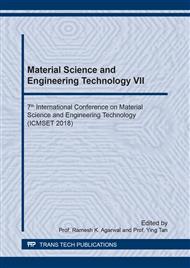p.97
p.103
p.110
p.117
p.123
p.128
p.133
p.138
p.144
Screen-Printed NiO-YSZ Thin Film Electrode for Solid Oxide Electrochemical Cell and Subsequent Reduction to Ni-YSZ
Abstract:
Nickel and yttria-stabilized zirconia (Ni-YSZ) ceramic-metal composite electrodes are commonly used for solid oxide electrochemical cells because of their good ionic and electronic conductivity. In this study, a thin film of NiO-YSZ was prepared via screen-print method and subsequently reduced to Ni-YSZ. The precursor powder for screen-printing was prepared via glycine-nitrate combustion process. The effect of precursor particle size and of the use of PVP as binder on film uniformity and quality were investigated. For the NiO-YSZ film, scanning electron microscopy (SEM) micrographs and X-ray diffraction (XRD) patterns confirmed that size reduction and the use of binder both improved the quality and uniformity of the deposit without changing the composition of the sintered film. SEM with energy-dispersive spectroscopy (EDS) showed elemental mapping of unreduced and reduced films, revealing micro grain size faceted particles of NiO and Ni, while smooth and much larger YSZ grains were also observed. XRD of reduced Ni-YSZ film revealed that the NiO peaks had been replaced by Ni.
Info:
Periodical:
Pages:
123-127
Citation:
Online since:
April 2019
Authors:
Keywords:
Price:
Сopyright:
© 2019 Trans Tech Publications Ltd. All Rights Reserved
Share:
Citation:


